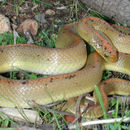en
names in breadcrumbs


Die Aurora-nagslang (Lamprophis aurora) is 'n nie-aggressiewe wurgslang wat in Suid-Afrika aangetref word. Die slang is hoofsaaklik snags aktief en kan uitgeken word aan die kenmerkende geel-oranje streep op sy rug.
Lamprophis aurora kan tot 'n maksimum lengte van 90 cm groei, maar korter lengtes rondom 60 cm is meer algemeen. Onvolwasse slange lyk op die kousbandjie en het 'n opvallende oranjebruin kleur, wat verdonker tot olyfgroen namate hulle ouer word.
Die slang word aangetref op die grond in grasvelde, beboste kusgebiede en fynbosgebiede; hulle waag dit nie in bome nie. Hulle word ook naby mense se wonings aangetref. Die slang se gewildheid as troeteldier, wat beteken dat dit in isolasie aangehou word, asook stedelike uitbreiding en boerebedrywighede vorm 'n bedreiging vir die slang. Natuurlike bedreigings sluit ander slange en roofvoëls in.
Volwasse Aurora-nagslange eet hoofsaaklik klein knaagdiere, terwyl jong slange se dieet tot akkedisse beperk is.
Die wyfie lê 5 tot 12 eiers vroeg in die somer. Die eiers broei in Desember tot Januarie uit en die kleintjies het 'n gemiddelde lengte van 20 cm.
Die Aurora-nagslang (Lamprophis aurora) is 'n nie-aggressiewe wurgslang wat in Suid-Afrika aangetref word. Die slang is hoofsaaklik snags aktief en kan uitgeken word aan die kenmerkende geel-oranje streep op sy rug.
Lamprophis aurora kan tot 'n maksimum lengte van 90 cm groei, maar korter lengtes rondom 60 cm is meer algemeen. Onvolwasse slange lyk op die kousbandjie en het 'n opvallende oranjebruin kleur, wat verdonker tot olyfgroen namate hulle ouer word.
Die slang word aangetref op die grond in grasvelde, beboste kusgebiede en fynbosgebiede; hulle waag dit nie in bome nie. Hulle word ook naby mense se wonings aangetref. Die slang se gewildheid as troeteldier, wat beteken dat dit in isolasie aangehou word, asook stedelike uitbreiding en boerebedrywighede vorm 'n bedreiging vir die slang. Natuurlike bedreigings sluit ander slange en roofvoëls in.
Volwasse Aurora-nagslange eet hoofsaaklik klein knaagdiere, terwyl jong slange se dieet tot akkedisse beperk is.
Die wyfie lê 5 tot 12 eiers vroeg in die somer. Die eiers broei in Desember tot Januarie uit en die kleintjies het 'n gemiddelde lengte van 20 cm.
The Aurora house snake,[1][2][3] Aurora snake, or night snake[1] (Lamprophis aurora) is a species of snake in the family Colubridae. It is endemic to Southern Africa (South Africa, Lesotho, Eswatini, Botswana).[1][2]
This species is widespread in South Africa (present all provinces but is absent from most of the Northern Cape) and also occurs in Lesotho[1] and Eswatini.[2] It is also recorded from eastern Botswana,[1][2] although this might represent a translocation.[1]
The snake can achieve a maximum length of 90 cm, but averages 45–60 cm.[3][4] Colour varies from shiny olive green to dull dark green above. A bright yellow to orange vertebral stripe runs from the top of the head to the tip of the tail.[3]
This species occurs in grassland, fynbos, and moist savanna habitats[1][3] at elevations up to 1,700 m (5,600 ft) above sea level. They are often found near streams and under rocks, and may occur in old termitaria.[1]
It is secretive[3] but can be locally common.[1] It is active at night (nocturnal).[5] The diet consists of rodents, lizards, and frogs.[3] The female lays clutches of up to 12 eggs.[4] It is non-venomous and seldom attempts to bite.[3][5]
Grassland habitats that this species inhabits are heavily transformed by urban development and agriculture, but it is not considered threatened because it remains common in suitable habitat and is widespread. Its range overlaps with a number of protected areas.[1]
The Aurora house snake, Aurora snake, or night snake (Lamprophis aurora) is a species of snake in the family Colubridae. It is endemic to Southern Africa (South Africa, Lesotho, Eswatini, Botswana).
Lamprophis aurora Lamprophis generoko animalia da. Narrastien barruko Colubridae familian sailkatuta dago.
Lamprophis aurora Lamprophis generoko animalia da. Narrastien barruko Colubridae familian sailkatuta dago.
Lamprophis aurora est une espèce de serpents de la famille des Lamprophiidae[1].
Cette espèce se rencontre en Afrique du Sud et en Eswatini[1].
Lamprophis aurora est une espèce de serpents de la famille des Lamprophiidae.
Lamprophis aurora – endemiczny gatunek węża z rodziny połozowatych.
Osobniki tego gatunku osiągają rozmiary od 50 do 80 centymetrów[2]. Najdłuższa zanotowana samica mierzyła 64,3 centymetra[3], samiec 45,9 centymetra[3]. Ciało w kolorze oliwkowo-zielonym. Na grzbiecie posiadają pomarańczowo-żółtą podłużną pręgę, która z wiekiem może ciemnieć. Podstawą pożywienia są gryzonie. Zjada także żaby, jaszczurki oraz inne węże. Samica składa w lecie 8 do 12 jaj. Inkubacja trwa 72 - 78 dni. Młode po wykluciu się mają długość około 20 cm[2].
Węże te występują w Republice Południowej Afryki.
 Alethinophidia
Alethinophidia Lamprophis aurora – endemiczny gatunek węża z rodziny połozowatych.
Osobniki tego gatunku osiągają rozmiary od 50 do 80 centymetrów. Najdłuższa zanotowana samica mierzyła 64,3 centymetra, samiec 45,9 centymetra. Ciało w kolorze oliwkowo-zielonym. Na grzbiecie posiadają pomarańczowo-żółtą podłużną pręgę, która z wiekiem może ciemnieć. Podstawą pożywienia są gryzonie. Zjada także żaby, jaszczurki oraz inne węże. Samica składa w lecie 8 do 12 jaj. Inkubacja trwa 72 - 78 dni. Młode po wykluciu się mają długość około 20 cm.
Węże te występują w Republice Południowej Afryki.